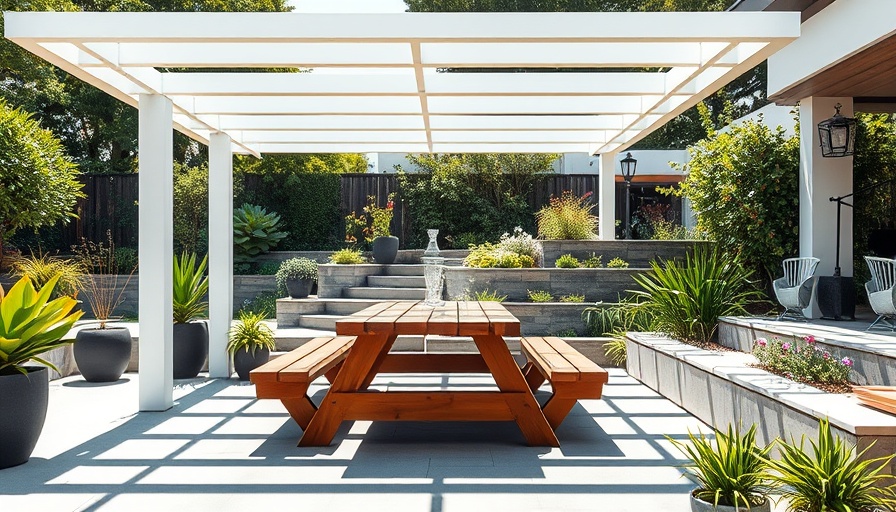
The Charm of Transforming Your Backyard
Transforming a steep backyard into an inviting multi-level garden is more than just an aesthetic upgrade; it's about enhancing familial bonds and creating a space for shared memories. The process described in Sloping Backyard Transformed Into Amazing Multi-Level Garden illustrates not just the physical construction, but the emotional journey of turning a neglected area into a flourishing haven for gatherings and personal rejuvenation.
In Sloping Backyard Transformed Into Amazing Multi-Level Garden, the discussion dives into the exciting journey of redesigning an awkward outdoor space, exploring key insights that sparked deeper analysis on our end.
Understanding Garden Design and Accessibility
The first step in creating a usable garden from a sloping backyard involves meticulous planning and landscaping design. By incorporating multiple levels, not only does it become visually appealing, but it also enhances accessibility for family members of all ages and abilities. This approach ensures that everyone can enjoy the space, whether for hosting parties or quiet moments of reflection.
The Importance of Professional Guidance
As the project progresses, as seen in the video, engaging professionals like engineers becomes essential, especially when dealing with major alterations in elevation. Neglecting the importance of proper drainage, for instance, can lead to catastrophic failures in retaining walls. Ensuring the water flow is directed adequately protects the integrity of the garden, conserving the beauty of the landscaping while preventing potential disasters.
Landscaping Techniques for a Beautiful Backdrop
Once the framework is established, the choice of materials is a critical factor in the overall design. From paving around the pool to selecting native plant species, each detail contributes to the sustainable ethos of the space. Choosing plants that require minimal maintenance, like the Dianella featured in the video, can reduce upkeep while still providing an attractive and inviting atmosphere.
Making the Most of Outdoor Spaces
Outdoor areas filled with practical, comfortable furniture can transform a simple backyard into a delightful entertainment zone. The addition of versatile seating arrangements, such as benches and tables, makes the space adaptable for various events—from family gatherings to friendly BBQs. These deliberate design choices amplify the importance of outdoor living.
Nurturing Nature: Plant Selection for Year-Round Beauty
In the finished garden, specific plants play a prominent role, especially those that offer color changes and attractions for local wildlife. For instance, the selected features such as acacias not only enhance visual appeal but also serve ecological purposes by providing shelter for birds. This blend of functionality with beauty illustrates the duality of a well-thought-out garden.
Creating a Sustainable Garden Dream
A key element emphasized throughout the transformation process is sustainability. Utilizing drought-resistant plants, like Tiff Tuff Bermuda grass, showcases eco-friendly practices that reduce water usage while maintaining a lush appearance. Sustainable gardening practices not only enhance the aesthetic but also contribute positively to the environment.
The Spirit of Community and Collaboration
One of the most heartwarming aspects of this project was the communal effort involved. Friends and family came together, showcasing the importance of teamwork in creating a shared vision. This aspect not only transformed the space but also reinforced relationships, highlighting how gardens can serve as catalysts for community ties.
The Transformative Power of Gardening
In essence, the journey from a steep, overgrown backyard to a multi-level garden encapsulates more than just landscaping. It symbolizes recovery, community, connection, and personal growth. Each planter and pathway narrates a story waiting to unfold, fostering an environment where memories are made and cherished.
This backyard transformation offers a golden opportunity for homeowners to engage in their spaces, pushing them to visualize the potential in their lawns and gardens. For those inspired to begin their own garden renovation, consider these tips:
- Plan: Start with a well-thought-out design that considers both functionality and beauty.
- Consult: Don't hesitate to engage professionals for structural projects.
- Choose Wisely: Select plants that complement the climate and require little maintenance.
- Collaborate: Invite family and friends into the process to create shared memories.
Your backyard could be the next transformation story!
 Add Row
Add Row  Add
Add 




Write A Comment